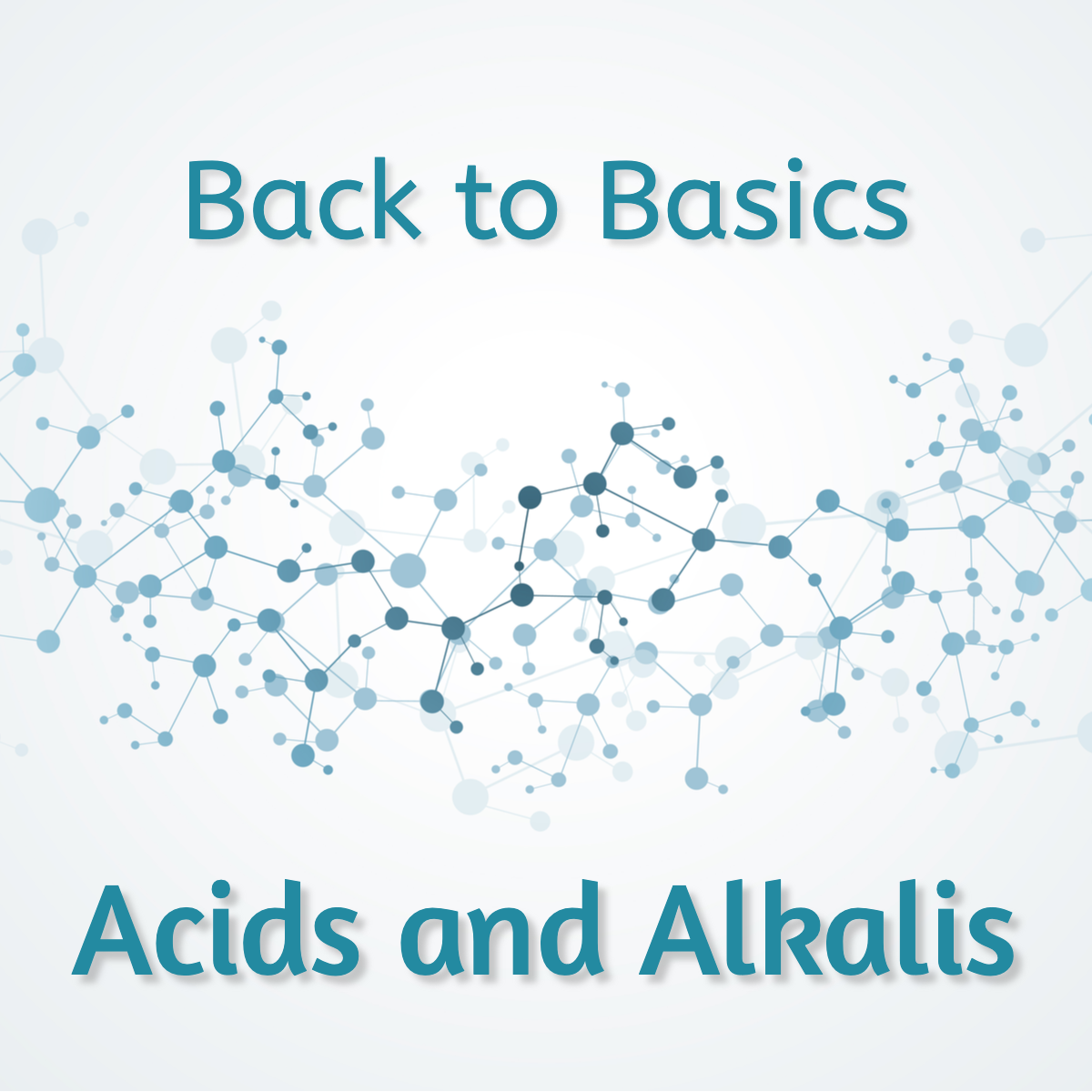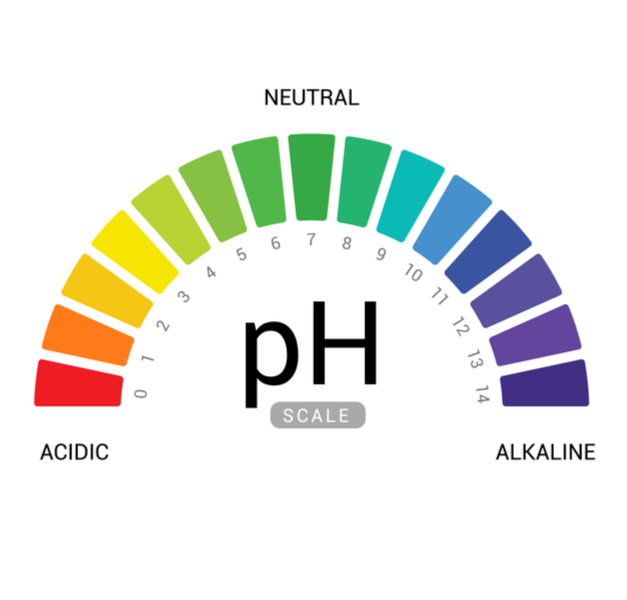
We are going back to basics today to build a strong foundation of understanding about acids and pH levels. This is in preparation for next week’s blog when we look at pH and skincare. But, you can’t have the conversation about pH without having a basic understanding of – you guessed it – Acids and Alkalis.
What is pH?
Thanks to the good folks at Britannica.com we know that pH is a “quantitative measure of the acidity or basicity of aqueous or other liquid solutions.” This applies to basic chemistry, biology (and skincare), and agronomy (growing things).
Generally, pure water is neutral with a pH of 7. Less than 7 is acidic and more than 7 is base (aka alkaline).
The measurement is actually about the concentration of hydrogen ions or potential Hydrogen (pH),
but for our purposes we can work with the rainbow scale.

Each number is a 10-fold change in acidity or basicness so the different numbers matter.
Acids
If you’re like me, when you hear “acid” you immediately think of someone’s face being melted off. I think of battery acid, citric acid, acid rain. For some reason, I always associated the word “chemical” with “acid” – which is wholly inaccurate. Pretty much everything is a chemical – since chemical merely refers to something made of matter. Water is a chemical. Oxygen is a chemical. You and I are chemical. Our skin is chemical.
When someone has a “chemical peel” ask, what is the pH of the solution used? Is it an acid or a base?
So an acid is merely something with a LOWER pH than pure water. It can be mildly acidic and still be called an acid. Think of all of the acids we love for anti-aging – hyaluronic acid, lactic acid, glycolic acid, vitamin C. Some acids are the bread and butter for youthful skin!
Alkalis
While I had very strong associations with acids, it’s intriguing that I have almost none for alkalis. I don’t associate them with their pH but I know that lye (come to find out it’s an alkali!) is not something you want to get on your skin in a concentrated form.
Don’t be confused by the many terms. These go by base, basic, alkali (singular noun), alkalis (plural noun) and alkaline (adjective). It all refers to the same thing.
Alkalis have some common properties which would be good for my brain to remember. They are caustic in concentration and they have a soapy or slippery feel. It’s not surprising that lye is involved in the creation of soap. Alkalis can dissolve fats, oils, and protein-based substances.
If you enjoy the macabre, here’s an article on whether an acid or an alkali is better to dissolve a body. Gross.
Acids and Alkalis in Daily Life
So now that you have a rudimentary understanding of the difference between acids and alkalis, you may wonder why knowing this matters. Okay, you’ve gotten along fine up to now without knowing about pH levels – but remember that learning new things keeps your brain young – so hang in there for anti-aging reasons if for nothing else!
PH levels show up in our daily lives. If you look around and pay attention, you’ll find it creeps in just about everywhere. Acids, alkalines, and pH – oh my!
As I was researching this, talking my brain out of long held but totally wrong notions, I found it sparked my curiosity. Here are some top-of-mind categories that came to mind as the pieces started to fit together.
Water – The US Geological Survey routinely tests water samples to determine pollutants. As noted above, pure water has a neutral pH of 7. If you are old enough to remember acid rain in the Adirondacks in upstate New York in the late 80’s, you already understand the notion of environmental pollutants changing the pH of rain water.
Gardening – If you like hydrangeas, you probably already know something about acidic and alkaline soils. Depending on the pH of your soil, the color of the hydrangeas will be different. How cool is that?! This is something I’ve always known about even though I’ve never grown hydrangeas. I suspect it fascinated my mother so it was memorable when she shared it with me. A pink hydrangea has more neutral soil and a blue hydrangea grows in a more acidic soil. If you want a deep dive into the world of gardening, this is a great resource. Of course, you have to test your soil pH and then you can determine from there if you need to amend it to make it more acidic or alkaline based on what you want to grow. I’d love to blame my lack of success with certain plants on my soil pH – but I’m pretty sure it’s just me!
Household Products – Cleaners can be acidic or alkaline, depending on what their purpose is. Bleach, ammonia, and laundry detergents are alkaline. Vinegar is an acid. You get the picture. Thankfully the companies that formulate cleaners take care of this acid/alkaline balance and just tell us what product to use for what outcome.
Foods – If you have an ulcer or other condition that requires you to beware of acidic foods, this is second nature to you. I always find it surprising. Citrus fruits are acidic. Tomatoes are mildly acidic. Nuts and legumes are generally alkaline.
I am NOT a dietitian or nutritionist. I simply find this intriguing. Speak with your doctor about any food considerations and do research on your own to become educated on any topic which interests you.
Baking powder has both a base (baking soda) and an acid (cream of tartar) in it to create the leavening reaction for food. By contrast, baking soda is a base but it’s used in the same manner – to react with the ingredients to cause “rise”.
You know, I always wondered how they were different but never took the time to find out!
Body – Normal blood is neutral leaning towards alkaline with a pH of 7.35 to 7.45. Normal stomach fluid is acidic with a pH of 1.5 to 3.5. Natural skin surface pH is below 5 (that puts us in the acid range) but can vary wildly based on pollutants, makeup, skincare products, and other conditions. You can test your skin pH with a kit – but I’ll be honest – I haven’t done it. This has the feel of a slippery slope for me. I’ve had to learn that for me, sometimes there is such a thing as too much information!
That’s enough for this week. See if knowing this sparks any new questions or ideas for you. Leave them in the comments below if you want!
Stay tuned next week for pH, skincare and why we should care.